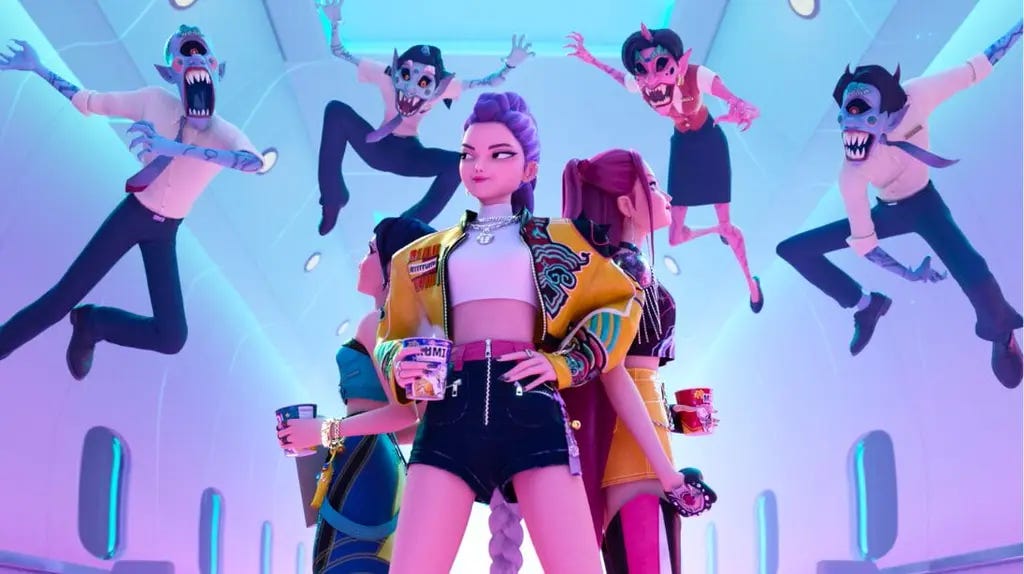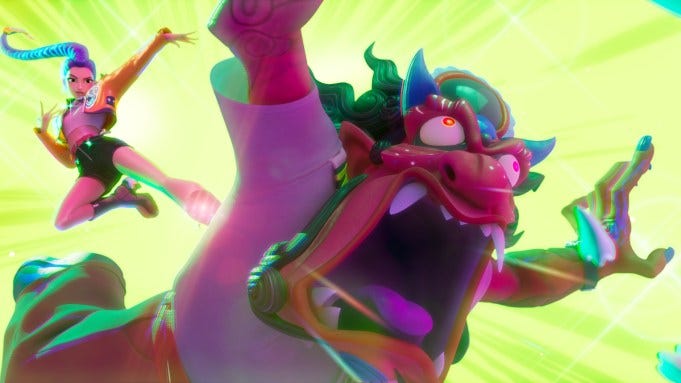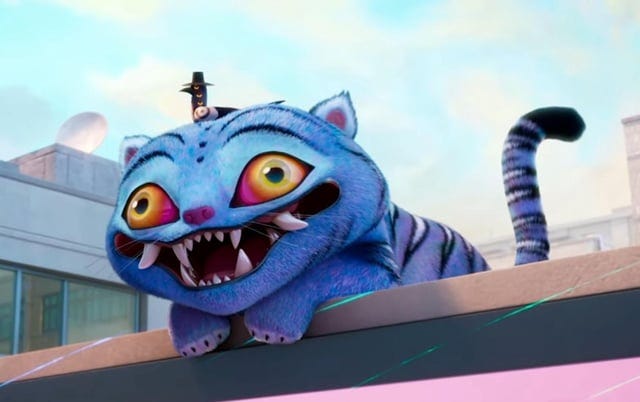The Therapy Generation is making kids movies now, and we’re all better for it
How KPop Demon Hunters is breaking patterns, banishing shame, and healing a lot more than the Honmoon
Beware! Reading further invites encounters with spoilers for Sony Pictures Antimation’s KPop Demon Hunters (2025):
As a film teacher, there was one lesson I prayed my most pretentious students would one day be able to accept: some of the best movies require you to get over yourself a little. This wasn’t, and still isn’t, a call for them to turn their brains off completely, but to suspend the face-scrunching presumption that invades us all when we’re confronted by “lower” forms of media. I’ll never stand in the way of someone’s deep devotion to Wes Anderson or Francis Ford Coppola, but there’s a bright shiny universe of incredible films out there that haven’t – and likely never will – worm their way into the Criterion Collection.
I still believe that Legally Blonde 2: Red, White, and Blonde has more to offer about the dark realities of the American political world than Mr. Smith Goes to Washington, and Magic Mike XXL has more to say about male camaraderie and masculinity than Fight Club.
This is why, when myself, my husband, and one of our good friends had a “boys night” last week, we saw KPop Demon Hunters sitting right at the top of the Netflix menu, piled onto the couch with a plate of freshly baked snickerdoodles, and strapped in.
Without the movie night motivation, I don’t know how long it would have taken me to get curious enough to give this film a whirl. I am not a KPop fan (though I taught high school long enough to get it), and I don’t have a strong love for the animation style we glimpsed in the 20 second preview, but there’s something about digging into whacky unfamiliar media with good friends and a few home baked edibles that overcomes all hesitation. If it was corny and unbearable, we would at least be in it together.
But that’s not what happened.
If you haven’t seen it, the story of KPop Demon Hunters follows Korean girl trio Rumi, Mira, and Zoey – known by the collective moniker Huntrix – as they attempt to rid the human world of the demons who have been stealing human souls on behalf of their master for thousands of years. It’s a pretty straightforward “kickass musician girls sing songs and kick a lot of ass” plot that is just simple enough to click in for the middle school demographic it’s surely targeting. There’s a “will they/won’t they” subplot with a demon boy, questions about identity, legacy, and friendship, and a couple of tracks that I surreptitiously added to my Spotify favorites before the final credits. All of that, I was expecting. What we didn’t see coming was the Message.
When I was growing up, movies and TV shows that shared thematic commonalities with KPop Demon Hunters (think Josie and the Pussycats, Spice World, Totally Spies, Bring It On, etc) had a pretty straightforward thesis statement: Be true to yourself!
They, largely, skipped over the hard part, which is what the fuck does that mean?
The more we learn about the generation who made those pieces of landmark media, the more it makes sense. Of course they didn’t dig in much deeper– they didn’t know the answer to that question either. It’s only in the last decade or so that we’re seeing more and more of us unraveling the stigmas around therapy, healing, and generational cycle breaking. Instead of making fun of each other for feeling things, we’re figuring out how to just, you know, feel them.
In KPDH (I’m going to start abbreviating– I can’t keep typing it all the way out), the filmmakers manage to take what could just be an empty money printing machine an imbue it with something real and meaningful, because this movie is, ultimately, a masterclass in recognizing and addressing shame.
Demons, it turns out, are just a vehicle for this conversation. Shame is the real enemy here, with main character Rumi carrying the full emotional and physical weight of a shame she inherited from a mother who is long gone. The more she tries to hide it, the more it takes over her life– worming its way into her performances, her friendships, and ultimately taking an un-ignorable physical toll on her body.
There are a lot of little moments that stack into something impressive and new here, especially for children’s media. We see the trio on a trip to the doctor who might be able help Rumi with her physical ailments. He offers instead, after a comically unsettling exam, this insight:
“To treat the part, you must understand the whole.”
My husband, who sits on an impressive TWO masters degrees in education and social work, muttered a quick “holy shit, this guy gets it.”
Because that, for the generation of us who are working to unlearn the cycles of shame and avoidance passed down to us, is the single most important lesson we’re all learning. There are no “life hacks” for skirting around the challenging feelings and the lowercase and capital T traumas we’re trying to understand. Slowing down, learning to sit in discomfort, and finding the path to honesty is fucking hard. And for those of us of a certain age, we very likely didn’t have a lot of models for it as we were growing up.
And yeah, KPDH isn’t super subtle about a lot of this messaging. Again, this is a movie written for older children slash younger adults– they aren’t going for Eraserhead or Brazil levels of complexity in symbolism here. This is a story written to be understood.
Arguably, the character most burdened by shame within the film is the one who has had the most time to stew in it. Jinu, lead vocalist of the rival secretly-demon all-guy singing group the Saja Boys, has been pickling in his own shame for 400 years. Plagued by memories of a betrayal from his past, he is both our main antagonist and primary love interest. And admittedly, as someone who spent a large part of my teenhood writing antagonistic fan fiction, this lit up the pleasure center of my brain in a truly demonic fashion. His motivation for dooming humanity and assisting the True Big Bad? He wants those memories erased.
And honestly, I get it.
For those of us engaged in the work of unraveling our own learned shame, “I wish I could just forget” is not an uncommon sentiment. Memory is a motherfucker, and we have a way of twisting and questioning and distorting our own memories into torture chambers of our own design. And when we put our brains into lockdown? The shame grows.
There’s really no way to get all the way through a think piece about shame without mentioning Brené Brown. In fact, she felt like this distant specter behind the outline of the entire movie. Even if the filmmakers have never even heard of her, the researcher and author of books like Dare to Lead and Atlas of the Heart could have designed the blueprint for the way KPDH engages with shame.
Brown calls shame “the intensely painful feeling or experience of believing that we are flawed and therefore unworthy of love or belonging.” She also says that “If you put shame in a petri dish and cover it with judgment, silence, and secrecy, you’ve created the perfect environment for shame to grow until it makes its way into every corner and crevice of your life.”
The antidote to shame, it turns out, is compassion. Chiefly, self-compassion. When we find our way to accepting ourselves where we are, it’s a hell of a lot easier to find the door out of shame. You might have also heard the tidbit of wisdom: “shame thrives in secrecy.”
This is where I can’t stop thinking about one of the only “adult” characters in KPDH: Celine.
A friend and former bandmate of Rumi’s mother, Celine plays the part of both mentor and secret keeper. She knows Rumi’s shame, because she’s the one who gifted it to her. Anyone with parents who ever encouraged us to “keep it in the family” might know the words to this one:
We don’t tell family secrets.
There’s no reason to go around talking about this.
This shame stays between us.
Rumi knows it too. Told from the moment she could walk that her “faults and fears must never be seen,” she bottles her shame deep inside, and only after a chance secret-revealing encounter with Jinu, realizes the potential healing power of facing her internalized maladies head on. It’s in talking and in feeling seen that Rumi begins to heal. It doesn’t happen all at once, but it does happen.
Now’s a good time, I think, for the rest of that Brené Brown quote:
“If, on the other hand, you put shame in a petri dish and douse it with empathy, shame loses its power and begins to wither. Empathy creates a hostile environment for shame—an environment it can’t survive in, because shame needs you to believe you’re alone and it’s just you.”
It turns out that every character in this universe is cradling a different shame in an airtight container. Mira worries that she is undeserving of family. Zoey believes that she is expendable and burdensome. Even the girls’ manager, Bobby (who, I was delighted to discover, is voiced by the indomitable Ken Jeong) wrestles with feelings of inadequacy and resentment.
Suddenly, being true to yourself is a much more concrete ask from a children's movie.
For anyone who’s ever read anything else I’ve written, this subject could seem like a bit of a departure for me. As a trans man who made a career in education, something like my book, Teach Like an Ally (hitting shelves at the end of the month) makes a lot more sense. We’re sixteen hundred words into this article and I haven’t mentioned anything about the gays– what gives?
Don’t worry, here they are:
I just got back from a day trip to a museum that sits just on the upper rim of the city of Los Angeles: the Getty. This is because the Getty is putting on a summer-long exhibit highlighting queer art– chiefly queer photography – and I knew I had to get a visit in before I left the state. It was within this photography exhibit that I found myself taking an extra long pause in a room filled with floor-to-ceiling portraits of notable queer pioneers. From Alan Turing, George Washington Carver, and Audre Lorde, to Ru Paul, John Waters, and Annie Leibovitz, the whole scene was a little overwhelming and hard to take in all at once. It was the most crowded room in the installation, and I found myself mostly just enjoying other people’s experience with it.
I was just about to leave when a young mother wandered in with her daughter. I’m not great with younger kid ages (but after a decade teaching in secondary ed, I can tell you the difference between 15 and 15 and a half), but I would guess the little girl was just shy of nine. She pointed out a photo of Frida Kahlo and asked her mother the kind of a-little-bit-too-loud question that kids are famous for:
“Wait, Mommy, was she a lesbian?”
I braced for how I’m trained to expect parents to react, especially around queer topics. Maybe an arm jerk and a harsh whisper? A flustered stammering and embarrassed exit? Nope.
“Who? Oh, her? No, I think she was bisexual actually.”
“Oh, okay!”
And then they moved on.
The experience stuck with me as I walked through the rest of the exhibit, and it wasn’t until I rejoined my husband and a group of our friends outside that I was able to put words to what I was feeling. This was a child being raised in what felt like a shame-free environment. She was allowed to ask questions, and she got answers. Her mother didn’t look around to see who was listening, or who might be judging her parenting. She just was. There was no way for shame to weasel its way in.
Over drinks at the museum cafe, I explained what I had seen.
Of all of us there, only one was a parent. Her partner, a nonbinary badass, told us what it was like to watch as she raised her children in a way that was so very different from the environment with which we were all familiar:
“Seeing her as a parent is incredible,” they said. “Her kids are allowed to just be who they are. There’s no judgment, and so much love. I feel like it's healing a part of me too.”
And maybe that’s why movies like KPop Demon Hunters stick to our ribs even though they aren’t made for us. We might be too old to be raised without shame, but it's never too late to hold the child inside of us as we do what we can to try and heal together.









I was at the Getty today to see both Pride exhibits. I was deeply moved by the gallery walls of our queer forebears too. I’m looking forward to your book release (I’m a community college Sociology professor).
As a 49yo who my brother-in-law described as “the one who got the guilt gene in the family”, this sounds like something to watch tonight. Thanks for this.